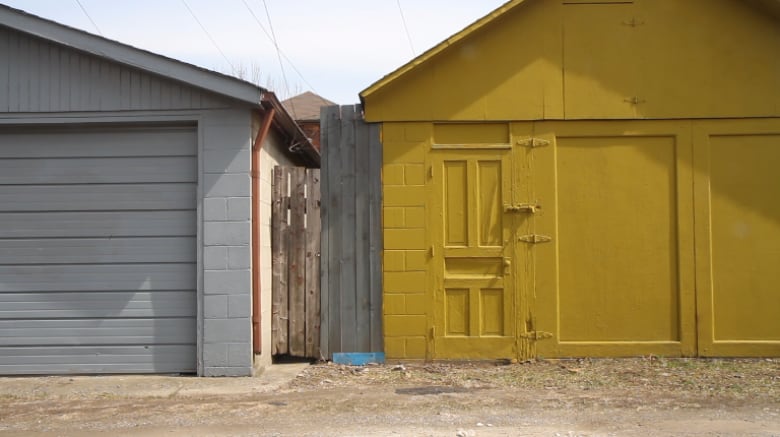Hamilton urban trail to cap off Listerine Alley's renewal
Infamous lane once a 'dumping ground' for bottles, needles and old furniture

The alley behind Chuck Eelhart’s Elgin Street home has become a labour of love for the 58-year-old retiree.
Almost every day, he scopes the laneway for morsels of trash. An amateur artist, he’s also bolted up a series of hand-painted signs that remind passers-by that “litter is unsightly” and that children traipse through the pathway on their way to school.
“For me, it’s just the pride of living here,” said Eelhart, who moved to from B.C. to Hamilton’s Beasley neighbourhood in 2008. “That’s the whole motivation.”
The former real estate agent and his neighbours are about to get a big dose of help in keeping the path clean. Once a symbol of blight and deprivation in Hamilton’s lower city, the alley is set for a major refresh as part of a city-backed pilot project to create an “urban trail” that spans from just below the Mountain all the way to the North End.
In early April, the city approved $230,000 for the alley beautification project, one of the proposals that residents voted to fund as part of Ward 2’s first round of participatory budgeting. The major upgrades include paving the laneways and installing overhead lighting, and will involve additional citizen-suggested measures to give the spaces a more human touch.
'It was really bad'
The lane behind Eelhart’s house will be the first to be updated. Colloquially referred to as “Listerine Alley,” it’s wedged between Elgin and Mary streets, runs from Cannon Street to the south and Barton to the north, and is interrupted by Robert Street in the middle.
'It was the dumping ground for the local neighbourhood, I believe. Couches, chairs, probably more than fifty tires, lots of needles and such.'— Chuck Eelhart
The moniker stems from the lane’s once-sordid reputation. Located just steps away from the Barton jail and the Wesley Centre, one of Hamilton’s largest homeless shelters, the alley was once littered with bottles of mouthwash from addicts too broke to purchase booze from the nearby beer store.
When Eelhart and his wife moved to the neighbourhood in 2008, the lane, which is lined by backyard garages, “was really bad,” he said.
“It was overgrown and full of garbage. It was the dumping ground for the local neighbourhood, I believe. Couches, chairs, probably more than fifty tires, lots of needles and such.”

A small group of neighbours got together and organized a big cleanup, lugging out the refuse and painting over graffiti. With the help of then-councillor Bob Bratina, they enlisted city hazardous waste crews to help with the dangerous task of plucking hundreds of used needles from the route.
Dumping continued, though, and so did the graffiti. It didn’t discourage Eelhart from working to keep the space clean.
“We were hit with graffiti and garbage and we had persistent dumpers, but I never took it personally. I’d just clean it up.”
But he’s seen a lot of improvement. Last week, Eelhart said, he went days without finding much of any trash. Children use the alley to walk to and from school. And even though the lane is still used on occasion as a hideaway drinking spot, he said he’s heard participants tell each other to clean up their empties so not to upset the neighbours.
Next level
Armed with city dollars, Ward 2 community groups are looking to take the change to the next level, envisioning the lane, and others like it, as a peaceful, greenery-lined walking path and possibly, a neighbourhood gathering space.
“You’re basically right in middle of the city,” said Charlie Mattina, a member of the Beasley Neighbourhood Association who’s involved in the project. “So having some sort of trail that you can go through… you get yourself away from the hustle and bustle of all the streets.”
We want to integrate it into the fabric of the neighbourhood.— Charlie Mattina, Beasley Neighbourhood Association
There have been discussions, he said, about laying down a special type of gravel instead of paving with asphalt to ensure better drainage, installing planters along the route, and painting murals on some of the walls that line the lanes — ideas that spring from a landmark Chicago initiative to turn a number of that city’s alleyways into inviting public spaces.
Residents, Mattina said, will have the opportunity to work with city staff to help plan the future shape of the alley at an April 23 design charrette at the Beasley Community Centre.
Whatever residents decide, Mattina said, it’s important that the alley look cared for and that the space is “inclusive.”
“We want to integrate it into the fabric of the neighbourhood.”
'Sit in my yard and smile'
For his part, Eelhart is not interested in getting involved in the planning process. He prefers to contribute is his own solitary way — working with his hands — without having to butt heads with people who have opposing ideas.
But he said he’s open to changes that would make the alley out back a brighter, friendlier space.
“All those things are fine by me,” he said. “I’ll probably just sit in my yard and smile."